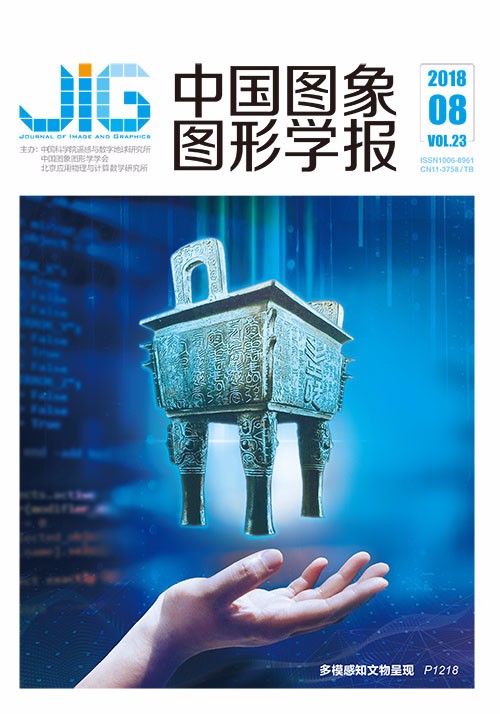
国画的艺术目标分割及深度学习与分类
摘 要
目的 现有对艺术画进行分类的文献大多对整幅画作直接进行特征提取,但任何图像内容特征的可适应性都存在一定的局限性。画家画不同艺术目标的笔锋和艺术处理往往是不同的,如果不考虑每个笔锋所产生的条件而一味地分析笔锋的走向和力度分布等将会是很盲目的。为此提出一种基于艺术目标的中国画分类算法。方法 首先,基于简单线性迭代聚类算法根据像素间颜色和位置的相差程度来生成超像素;其次,提出针对艺术目标的最大相似度区域合并算法交互式地进行艺术目标分割,将国画分割成一系列的艺术目标,如马、人物等,以提取画家用来表现艺术形式和抒发情感的相对稳定单元;然后利用深度卷积神经网络(O-CNN)来描述这些艺术目标的高级语义特征;最后,引入支持向量机对每幅中国画内的各种艺术目标的分类结果进行最后的融合与分类。结果 本文针对艺术目标进行国画的学习和分类,实现了对样本库中10位画家中国画的识别,平均准确率为89%。实验结果表明,本文算法在平均查全率和查准率上优于现有的MHMM (The 2D multi-resolution hidden Markov model)和Fusion等方法。结论 本文的成果可用于中国画的数字化分析、管理、理解和识别,为中国画传承和鉴赏提供有效的数字工具。
关键词
Learning artistic objects for improved classification of Chinese paintings
Sheng Jiachuan, Li Yuzhi(School of Science and Technology, Tianjin University of Finance and Economics, Tianjin 300222, China) Abstract
Objective Presently, existing research on art classification is primarily based on feature extraction and hence feature-based classification. Although such feature-based methods reported in the literature achieve a certain level of success, a major weakness lies in the considerable dependence of classification performances on the effectiveness of the features in describing the content of Chinese paintings. Given that traditional Chinese artists tend to rely on popular objects, such as figures, trees, flowers, birds, mountains, horses, and houses to express their artistic feelings and emotions, we explore a new concept of artistic object-based approach to classify traditional Chinese paintings in this study. In this way, automated classification can be integrated with perception, understanding, and interpretation of artistic expressions and emotions via the segmented artistic objects. Such an approach also possibly enables our proposed methods to be further developed into an interactive object-based classification approach for other forms of paintings. In comparison with the existing state of the arts, one advantage of our proposed approach over those based on features or content is that objects provide direct and integrated art expressions inside paintings. Method Our proposed method includes three stages of processing and analytics for traditional Chinese paintings, that is, 1) interactive art object segmentation; 2) description and characterization of art objects via convolution neural network (CNN), the most popular deep learning unit; and 3) SVM-based classification and fusion across all art objects. Specifically, via an iterative linear clustering algorithm, super-pixels are constructed to detect the difference between the color and position of each individual pixel. By maximizing the similarity within the neighborhood of those super-pixels, a sequence of objects can be segmented, and an interactive scheme can be designed, allowing users to add, revise, and interact with the content of paintings to achieve the best possible balance between subjective demand and objective art description. Afterward, a CNN-based deep learning unit is added to describe those objects, so its classification can be carried out with regard to the individual art object. Finally, an SVM unit is adopted to achieve the final fusion of all these classifications via consideration of each individual object within the given window, which is influenced and initialized through the training process. Result Extensive experiments are carried out, which are in four phases, each of which considers one impact factor, such as consideration of the number of artists, comparison with the existing state of the arts, consideration of benchmarking via content-based classifications, and assessment of contributions from CNN alone. Experimental results show that our proposed algorithm:1) outperforms several existing representative approaches, including MHMM and fusion-based method, 2) achieves effective fusion of all different object classifications, including CNN and SVM units, 3) captures the artistic emotions through those segmented art objects, and 4) shows potential for interactive classification of Chinese paintings via segmentation of artistic objects. Conclusion This study proposes the computerized classification and recognition of art styles based on artistic objects in paintings rather than the whole paintings. Experimental results reveal that the proposed algorithm outperforms the existing representative benchmarks, providing potential for developing effective digital tools for computerized management of Chinese paintings. In addition, this method can be used to formulate an important tool for computerized management of Chinese traditional paintings, providing a range of techniques for effective and efficient digitization, manipulation, understanding, perception, and interpretation of Chinese traditional arts as well as its legacy.
Keywords
artistic object segmentation classification of Chinese paintings convolutional neural network fusion algorithm deep learning superpixel segmentation
|



 中国图象图形学报 │ 京ICP备05080539号-4 │ 本系统由
中国图象图形学报 │ 京ICP备05080539号-4 │ 本系统由